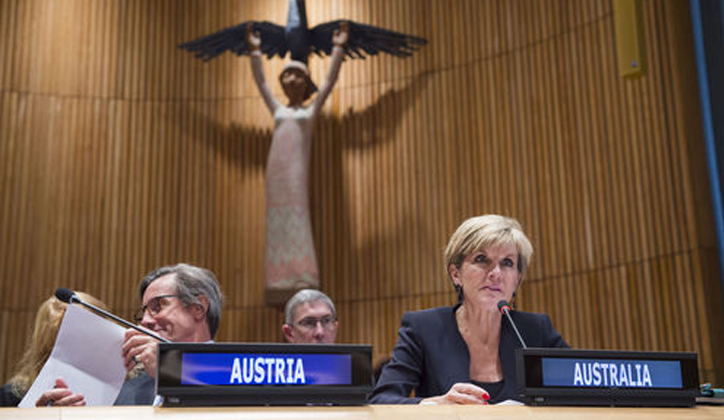This article was originally published by Adam Lockyer and Michael Cohen on The Conversation, and shared as part of the Creative Commons.
Earlier this week, Foreign Minister Julie Bishop made some comments flagging a significant shift in Australia’s position on the Assad regime in Syria.
According to Bishop, if the Assad regime were to be removed or collapse, it would create a vacuum that could be filled by “an even more diabolical presence”. As a consequence, Australia’s position is now that all options should be considered.
Also this week, Russian warplanes and helicopter gunships launched their first airstrikes on rebel-held positions inside Syria. So are these two events in any way linked?
The short answer is yes, but it’s a complicated picture.
Shorter term
For the “yes” side, Russian airstrikes were expected. There were signs for several weeks that Russia was preparing to dramatically increase its involvement in the Syrian conflict.
Earlier this month, there were reports of Russians delivering prefabricated housing for about 1000 people. This led analysts to speculate that Russia was about to commit its own air defence units and modern combat aircraft.
Russia’s principal objective is to ensure that it continues to wield influence in post-civil war Syria. Syria is Russia’s last remaining ally in the Middle East.
But Russian President Vladimir Putin’s support of his Syrian counterpart, Bashar al-Assad, is not unconditional. A top diplomat reported that, in 2012 – when Assad’s hold on power was considered tenuous – Russian diplomats approached the US, France and Britain with a peace plan that would have seen Assad removed from power.
What is important to Russia is that it continues to exercise influence within Syria. The vessel it uses to achieve this is negotiable.
Western countries dismissed Russian overtures because they believed that the Assad regime would be overthrown in a matter of weeks. But, in 2015, Russia will not easily abandon a resurgent Assad.
The strength of both Assad and Islamic State (IS) mean that there are two avenues to a quick end of the civil war:
- There could be a negotiated settlement between Assad, IS, and the more minor players, which formalises the status quo. This is unacceptable to the West and others who view IS as a serious security threat.
- The foreign powers can throw their weight behind the Assad regime and help it defeat IS. This now may be the better of two bad options.
Also on the “yes” side is Australia wanting to make clear to the Russians that the RAAF missions over Syria are not targeting Assad. If Russian air defence units and warplanes believe that Australian aircraft are working against the Assad regime, the airspace over Syria might become dramatically more dangerous for Australia’s pilots.
Longer term
There are three significant points to make on the “more to it” side of the ledger.
First, the change flagged by Bishop would align Australian diplomacy with its military actions. There is no denying the Assad regime’s barbarity and the horrific 240,000 deaths that the Syrian civil war has now produced.
But, international relations often offer only bad options, and we must select the least worst policy. The painful reality is that however undesirable Assad is, his regime is better for local and regional stability than no government. And we must conclude from a few years of failed diplomacy that any power-sharing arrangement between Syria’s disparate ethnic groups would most likely have collapsed. This could have led to a fierce civil war, like that which took place in Iraq in 2005 and 2006.
The only thing worse than an Assad government would likely be an IS government. There is good reason to expect that this would follow Assad’s imminent departure.
Second, Bishop’s changing position might be suggestive of a larger paradigm shift in Australian foreign policy. The Abbott government exhibited the neoconservative tendency to categorise actors into either liberal democracies or threats to liberal democracy.
Tony Abbott was willing – and sometimes even eager – to confront perceived challenges to liberal democracy, whether it was IS in the Middle East or Russia in Ukraine. It is difficult to imagine the Abbott government negotiating with Putin or Assad on Syria’s post-war governance, even when such diplomacy might save lives.
The suggestion that new Prime Minister Malcolm Turnbull may be willing to contemplate a post-civil war political arrangement that includes the continuation of Russian influence and a place for Assad’s Ba’athist Party might be a sign of Turnbull-Bishop pragmatism.
Finally, it might be a sign that Australia may at last be developing a strategy in Syria. Despite its brutality, the Assad regime does have a constituency in Syria. Without a support base, the regime would have folded like a paper tiger within the war’s opening weeks. Its constituency includes the Alawite sect, some Shi’a groups, and other minorities including some Christian groups who fear life under IS even more than Assad.
These groups’ interests will need to be represented in post-civil war Syria.
Regardless of the reasons, though, the real winners this week in international diplomacy have been Assad and Putin.
Catch up on recent contributions to The Conversation from other Macquarie authors.

